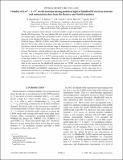Viability of Delta m(2) similar to 1 eV(2) sterile neutrino mixing models in light of MiniBooNE electron neutrino and antineutrino data from the Booster and NuMI beamlines
Author(s)
Karagiorgi, Georgia Stelios; Djurcic, Z.; Conrad, Janet; Shaevitz, M. H.; Sorel, M.
DownloadKaragiori-2009-Viability of.pdf (2.015Mb)
PUBLISHER_POLICY
Publisher Policy
Article is made available in accordance with the publisher's policy and may be subject to US copyright law. Please refer to the publisher's site for terms of use.
Alternative title
Viability of Δm2∼1 eV2 sterile neutrino mixing models in light of MiniBooNE electron neutrino and antineutrino data from the Booster and NuMI beamlines
Terms of use
Metadata
Show full item recordAbstract
This paper examines sterile neutrino oscillation models in light of recently published results from the MiniBooNE Experiment. The new MiniBooNE data include the updated neutrino results, including the low-energy region, and the first antineutrino results, as well as first results from the off-axis NuMI beam observed in the MiniBooNE detector. These new global fits also include data from LSND, KARMEN, NOMAD, Bugey, CHOOZ, CCFR84, and CDHS. Constraints from atmospheric oscillation data have been imposed. We test the validity of the three-active plus one-sterile (3+1) and two-sterile (3+2) oscillation hypotheses, and we estimate the allowed range of fundamental neutrino oscillation parameters in each case. We assume CPT-invariance throughout. However, in the case of (3+2) oscillations, CP violation is allowed. We find that, with the addition of the new MiniBooNE data sets, a (3+2) oscillation hypothesis provides only a marginally better description of all short-baseline data over a (3+1) oscillation hypothesis. In the case of (3+2) CP-violating models, we obtain good χ2-probabilities in general due to the large number of fit parameters. However, we find large incompatibilities among appearance and disappearance experiments, consistent with previous analyses. Aside from LSND, the data sets responsible for this tension are the MiniBooNE neutrino data set, CDHS, and the atmospheric constraints. In addition, new incompatibilities are found between the appearance experiments themselves (MiniBooNE, LSND, KARMEN and NOMAD), independent of CP-violation assumptions. On the other hand, fits to antineutrino-only data sets, including appearance and disappearance experiments, are found significantly more compatible, even within a (3+1) oscillation scenario.
Date issued
2009-10Department
Massachusetts Institute of Technology. Department of PhysicsJournal
Physical Review D
Publisher
American Physical Society
Citation
Karagiorgi, G. et al. "Viability of Delta m(2) similar to 1 eV(2) sterile neutrino mixing models in light of MiniBooNE electron neutrino and antineutrino data from the Booster and NuMI beamlines." Physical Review D 80.7(2009): 073001. © 2009 The American Physical Society
Version: Final published version